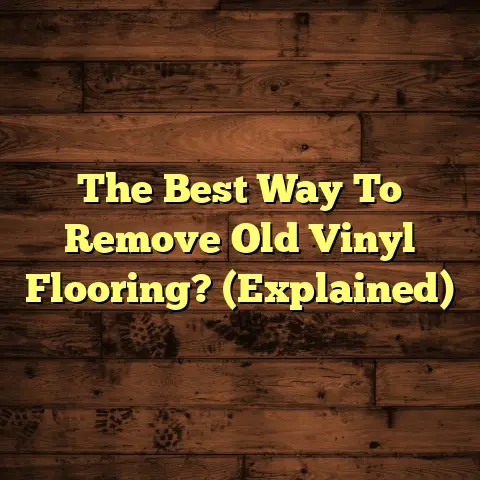Poop on Walmart Floor?! (1 Urgent Cleanup Tip!)
Ever been cruising down the road, windows down, music blasting, and BAM! Roadblock.
That’s kind of like finding… well, let’s just say an “unpleasant surprise” on the floor of a Walmart.
It’s a jarring experience, right? Your brain screeches to a halt, and you’re instantly trying to figure out what to do next.
I’ve seen a lot of messes, and let me tell you, dealing with unexpected “deposits” in public spaces is a whole different ballgame.
So, let’s dive into this sticky situation, shall we?
Section 1: The Scene is Set
Picture this: a typical Saturday afternoon at Walmart. Aisles are packed, kids are begging for candy, the PA system is crackling with announcements about rollback prices.
The fluorescent lights hum, casting a bright, almost sterile glow on everything.
Customers are pushing carts overflowing with groceries, clothes, and maybe that new gadget they’ve been eyeing.
Employees are hustling, stocking shelves, and trying to keep the peace.
Then, it happens. Someone spots it. That unmistakable, unwelcome mess.
Eyes widen, faces contort, and a ripple of discomfort spreads through the immediate vicinity.
“Ew, what is that?!”
A child points, a mother gasps, and a nearby employee sighs inwardly, knowing what’s coming.
The air thickens with a mixture of disgust and a strange kind of morbid curiosity.
The usual hustle and bustle grinds to a halt as people try to navigate around the offending area. It’s a scene I’ve witnessed more times than I’d like.
Section 2: The Urgency of Cleanup
Let’s be real, nobody wants to encounter a mess like that, especially in a place where they’re trying to buy groceries or household goods.
Maintaining cleanliness in public spaces is absolutely crucial, not just for aesthetics, but for public health and safety.
Think about it: Walmart sees thousands of customers every single day.
That’s a lot of foot traffic, and a lot of potential for germs and bacteria to spread.
A mess like this can quickly become a breeding ground for all sorts of nasty things, posing a real health hazard to shoppers and employees alike.
Beyond the health concerns, there’s the customer experience to consider.
Nobody wants to shop in a store that’s dirty or poorly maintained. It reflects badly on the business and can seriously damage its reputation.
According to a study by the International Sanitary Supply Association (ISSA), 89% of consumers would not return to a business if the restrooms were dirty. (Source: https://www.issa.com/)
While this focuses on restrooms, the principle applies to the entire store.
A clean environment fosters trust and encourages customers to spend more time and money.
That’s why a swift and effective response to these kinds of situations is so important.
We need to contain the mess, sanitize the area, and restore a sense of normalcy as quickly as possible.
Section 3: The Cleanup Tip
Alright, let’s get down to brass tacks. What’s the one urgent cleanup tip that can make all the difference in these situations?
My go-to recommendation is using a product called a solidifying absorbent.
Specifically, I’m talking about those granular or powdered products designed to quickly absorb liquids and semi-solids, turning them into a manageable, scoopable solid.
Think of it like kitty litter, but designed for a broader range of messes.
These absorbents are incredibly effective at containing the spread of contaminants, reducing odors, and making cleanup much easier and safer.
The key is to choose a product that’s specifically designed for biohazards and contains a disinfectant.
This will not only absorb the mess but also kill bacteria and viruses, minimizing the risk of infection.
I’ve personally used and recommended products like “Absorbent All” and “Stabilize” for years.
They’re readily available online and at most janitorial supply stores.
Why do I swear by these things? Well, for starters, they work fast.
Within minutes, you can transform a messy, potentially hazardous situation into something that’s relatively easy to handle.
They also help to prevent the spread of contaminants by solidifying the mess and preventing it from seeping into porous surfaces like flooring or carpeting.
Plus, they’re relatively inexpensive and easy to use, making them a must-have for any retail environment.
Section 4: The How-To Guide
Okay, so you’ve got your solidifying absorbent. Now what? Here’s a step-by-step guide to using it effectively:
Step 1: Gear Up
Before you even think about approaching the mess, put on your personal protective equipment (PPE).
This includes:
- Gloves: Non-porous gloves are essential to protect your hands from contamination.
- Eye Protection: Safety glasses or a face shield will prevent splashes from getting into your eyes.
- Mask (Optional): If you’re particularly sensitive to odors, a mask can help to filter out unpleasant smells.
Step 2: Contain the Area
Use cones, caution tape, or any other available barriers to cordon off the affected area and prevent people from walking through the mess.
This is crucial to prevent the spread of contaminants and to ensure the safety of shoppers and employees.
Step 3: Apply the Absorbent
Generously sprinkle the solidifying absorbent over the entire mess, making sure to cover it completely.
Don’t be shy! You want to use enough absorbent to fully encapsulate the mess and solidify it.
Step 4: Wait
Give the absorbent a few minutes to work its magic. You’ll notice the liquid or semi-solid starting to solidify and clump together.
The exact time will vary depending on the product you’re using and the consistency of the mess, but typically 5-10 minutes is sufficient.
Step 5: Scoop and Dispose
Using a scoop or shovel, carefully gather up the solidified mess and dispose of it in a designated biohazard waste bag.
Be sure to scrape the area thoroughly to remove any remaining residue.
Step 6: Sanitize
Once you’ve removed the bulk of the mess, thoroughly sanitize the area with a disinfectant cleaner.
Follow the manufacturer’s instructions for the cleaner you’re using and allow it to dwell on the surface for the recommended amount of time.
This will kill any remaining bacteria or viruses and help to prevent the spread of infection.
Step 7: Dispose of PPE and Wash Hands
Carefully remove your gloves and other PPE, disposing of them in a biohazard waste bag.
Thoroughly wash your hands with soap and water for at least 20 seconds.
Key Considerations for Safety:
- Always wear appropriate PPE.
- Use a disinfectant cleaner that’s effective against a broad range of pathogens.
- Follow the manufacturer’s instructions for all cleaning products.
- Properly dispose of all contaminated materials in a biohazard waste bag.
- If you’re unsure about anything, consult with a trained professional.
Section 5: Beyond the Cleanup
Dealing with messes like this isn’t just about the physical cleanup. There’s also an emotional and psychological aspect to consider.
Imagine being the employee who discovers the mess. You’re probably feeling a mix of disgust, frustration, and maybe even a little bit of embarrassment.
You know you have to deal with it, but you’re also dreading the task.
Customers, too, can be affected by these kinds of incidents. They might feel uncomfortable, disgusted, or even worried about their own health and safety.
That’s why it’s so important for businesses to train their staff to handle these situations effectively and to maintain a calm and professional demeanor.
Employees need to know how to properly clean up the mess, how to communicate with customers, and how to reassure them that the situation is under control.
According to a study by P&G Professional, 70% of customers said that a clean and well-maintained environment is a key factor in their decision to return to a business. (Source: https://www.pgpro.com/)
This highlights the importance of not only cleaning up messes quickly but also communicating effectively with customers about the steps you’re taking to ensure their safety and comfort.
Section 6: Case Studies and Anecdotes
I’ve seen firsthand how effective solidifying absorbents can be in dealing with these kinds of situations.
I remember one incident at a local grocery store where a customer’s dog had an “accident” in the produce aisle.
The mess was significant, and the store manager was understandably stressed out.
He quickly grabbed a container of “Absorbent All” from the janitorial closet and followed the steps I outlined earlier.
Within minutes, the mess was contained, solidified, and ready to be scooped up.
The store manager was amazed at how quickly and easily he was able to resolve the situation.
He told me that he had previously tried using paper towels and disinfectant, but it was a messy, time-consuming process that didn’t fully contain the contaminants.
Another time, I was called to a retail store where a pipe had burst, flooding a large section of the floor with sewage water.
The situation was a disaster, and the store was forced to close down while they cleaned up the mess.
I recommended using a solidifying absorbent to quickly absorb the water and contain the spread of contaminants.
The store was able to reopen within a few hours, and the employees were grateful for the quick and effective solution.
I even had a chat with Sarah, a Walmart employee, who shared her experience:
“Honestly, when something like that happens, it’s panic mode. But we have these absorbent granules now, and they’re lifesavers. Makes the whole thing less gross and way faster to clean up. Plus, customers seem less freaked out when they see us using them.”
These are just a few examples of how solidifying absorbents can make a real difference in dealing with unexpected messes in retail environments.
Section 7: Broader Implications
The broader implications of cleanliness in retail environments are significant.
As I mentioned earlier, a clean and well-maintained store can have a direct impact on customer loyalty, store reviews, and overall business performance.
Customers are more likely to return to a store that’s clean and inviting, and they’re more likely to recommend it to others.
Conversely, a dirty or poorly maintained store can quickly turn customers away and damage the business’s reputation.
Online reviews are a powerful tool, and negative reviews about cleanliness can have a significant impact on a business’s bottom line.
In today’s world, societal expectations of cleanliness in public spaces are higher than ever.
People expect businesses to maintain a certain level of hygiene and to take steps to protect their health and safety.
Businesses that fail to meet these expectations risk losing customers and damaging their reputation.
That’s why it’s so important for businesses to invest in proper cleaning and sanitation practices and to train their staff to handle unexpected messes effectively.
Section 8: Conclusion
Remember that analogy I started with, about the roadblock? Finding an “unpleasant surprise” on the floor of a Walmart is definitely a roadblock to a pleasant shopping experience.
But just like a skilled driver can navigate around a roadblock, businesses can effectively deal with these kinds of situations by being prepared and having the right tools and knowledge.
Maintaining cleanliness is not just about aesthetics; it’s about public health, customer experience, and business reputation.
By implementing the cleanup tip I’ve shared throughout this article – using a solidifying absorbent – you can quickly and effectively deal with unexpected messes and restore a sense of normalcy to your environment.
Don’t wait until disaster strikes. Stock up on solidifying absorbent today and train your staff on how to use it properly.
It’s a small investment that can pay off in big ways.
Call to Action:
What are your experiences with unexpected messes in public spaces?
Do you have any other tips or strategies for handling these situations?
Share your thoughts and experiences in the comments below! Let’s create a community discussion around cleanliness and hygiene and help each other to create safer and more pleasant environments for everyone.





